Nav view search
Navigation
Search
Vir Chakra Awardee List for the year 1966
| Wg Cdr | Peter Maynard Wilson 3590 GD(P) | Unit : No.16 Squadron | Award Date 21 Sep 65 | Announced 01 Jan 66 | |
| Details : | 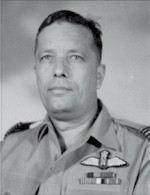 Wing Commander PETER MAYNARD WILSON (3590), General Duties (Pilot) - Wing Commander Peter Maynard Wilson was in command of a bomber squadron. In addition to the bombing raids undertaken at night over various parts ot Pakistan, his squadron was given the task of destroying the high-powered radar station near Badin in the Kutch area. The radar station was heavily defended by all calibres of anti-airciaft guns and it could also call upon its interceptor aircraft to defend it from any air attack. The nature of the target was such that it required extreme accuracy in bombing to achieve satisfactory results. It was, therefore, decided to under-take a low-level bombing raid in broad daylight so that the bomber crew could take full advantage of good visibility and achieve the utmost precision. With full knowledge of the dangers involved. Wing Commander Wilson led his squadron and attacked the radar station with confidence and determination. In spite of very heavy opposition, he and his formation successfully destroyed the radar station which was so vital to the enemy. The courage, leadership and skill displayed by Wing Commander Peter Maynard Wilson on this occasion were in the best traditions of the Air Force. Wing Commander PETER MAYNARD WILSON (3590), General Duties (Pilot) - Wing Commander Peter Maynard Wilson was in command of a bomber squadron. In addition to the bombing raids undertaken at night over various parts ot Pakistan, his squadron was given the task of destroying the high-powered radar station near Badin in the Kutch area. The radar station was heavily defended by all calibres of anti-airciaft guns and it could also call upon its interceptor aircraft to defend it from any air attack. The nature of the target was such that it required extreme accuracy in bombing to achieve satisfactory results. It was, therefore, decided to under-take a low-level bombing raid in broad daylight so that the bomber crew could take full advantage of good visibility and achieve the utmost precision. With full knowledge of the dangers involved. Wing Commander Wilson led his squadron and attacked the radar station with confidence and determination. In spite of very heavy opposition, he and his formation successfully destroyed the radar station which was so vital to the enemy. The courage, leadership and skill displayed by Wing Commander Peter Maynard Wilson on this occasion were in the best traditions of the Air Force. | ||||
| Reference: | Gazette of India , 12th February 1966 - No.15 - Pres/66 dated 1st January 1966 | ||||
| Wg Cdr | Om Prakash Taneja 3843 GD(P) | Unit : No.1 Squadron | Award Date 06 Sep 65 | Announced 01 Jan 66 | |
| Details : | 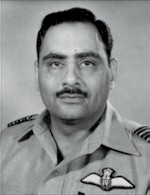 During the operations against Pakistan, Wing Commander Om Parkash Taneja showed inspiring leadership and set a fine example as a Squadron Commander by leading nine strike missions over enemy territory. On 6th September 1965, he led his Squadron for the first mission into enemy territory and destroyed fuel wagons in the Gujranwala sector. On 7th September 1965 he led a formation of 12 aircraft of the Squadron on a dawn strike over Sargodha Airfield. He started up during an air raid warning, when our anti-aircraft guns were firing. Shortly after the air raid he took off from a damaged runway having no runway lights. Through it was still dark, he led his Squadron successfully at low level to the target. On subsequent days he led a number of strike sorties in the Lahore and Sialkot sectors, attacking and destroying enemy tanks, vehicle concentrations and gun and mortar positions in these sectors. By his example he inspired confidence and courage amongst the junior pilots and won the admiration of all serving under him. | ||||
| Reference: | Gazette of India , 12th February 1966 - No.15 - Pres/66 dated 1st January 1966 | ||||
| Wg Cdr | Surapati Bhattacharya 3974 GD(P) | Unit : No.3 Squadron | Award Date 12 Sep 65 | Announced 01 Jan 66 | |
| Details : | 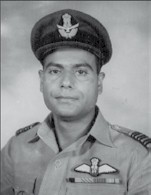 Wing Commander Surapati Bhattacharya was the Flight Commander of an operational fighter squadron in the western sector when the hostilities with Pakistan broke out. He took over the command of the squadron on 12th September 1965. He led a large number of missions against enemy armour and troop concentrations in close support of the army. In the face of enemy ground fire and air opposition, he pressed home his attacks and succeeded in destroying a number of enemy tanks, armoured vehicles and troop concentrations. In every operational mission undertook, he flew as the leader of the formation, and apart from the successes he achieved personally, he contributed to a great extent towards the successes achieved by the other aircraft of these formations. By his personal example, he inspired other officers and airmen and instilled in them a spirit of confidence. Wing Commander Surapati Bhattacharya displayed courage, determination and leadership of a high order in the best traditions of the Air Force. | ||||
| Reference: | Gazette of India , 12th February 1966 - No.15 - Pres/66 dated 1st January 1966 | ||||
| Sqn Ldr | Shri Krishna Singh 3996 ACCT | Unit : AFS Halwara | Award Date 06 Sep 65 | Announced 01 Jan 66 | |
| Details : | 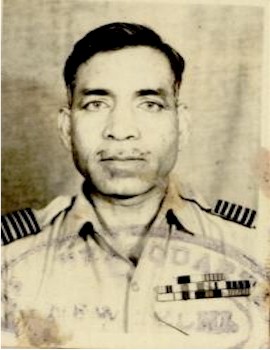 Squadron Leader Shri Krishna Singh was in charge of ground defence and security arrangements of an airfield when hostilities started with Pakistan. On 6th September 1965, over 60 Pakistani paratroopers, equipped with modern weapons and equipment, were air-dropped in the vicinity of the unit to carry out sabotage to our aircraft and installations. Squadron Leader Singh organised a mobile patrol and under his intelligent and able direction, the patrol foiled the enemy’s plan. Finding the airfield defences formidable, the paratroopers finally withdrew from the airfield and were captured by civil and army authorities. On 7th September, 1965, when information was received that some paratroopers had been hiding near a village, Squadron Leader Shri Krishna Singh volunteered to lead a mobile armed patrol to apprehend them. During this operation, he was able to apprehend three paratroopers, including the officer in charge of the Pakistani Para contingent. On an extensive search made under his supervision, 70 parachutes and a considerable quantity of automatic weapons and other equipment were captured. This bold action on the part of Squadron Leader Shri Krishna Singh made the paratroopers attack on the airfields ineffective. | ||||
| Reference: | Gazette of India , 12th February 1966 - No.15 - Pres/66 dated 1st January 1966 | ||||
| Sqn Ldr | Satish Nandan Bansal 4014 GD(N) | Unit : No.5 Squadron | Award Date 14 Sep 65 | Announced 01 Jan 66 | |
| Details : | 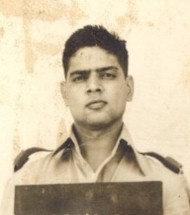 On 13th and 14th September, 1965, a massive bomber raid was mounted against Peshawar airfield, Squadron Leader Satish Nandan Bansal was selected to lead and mark the target. The target was so deep in the heart of enemy territory that the aircraft had to operate from a forward base and to follow a direct route so as to ensure enough fuel for return to base. Though clouds obscure the moon, Squadron Leader Bansal decided to navigate at low level among the hills in order not to disclose the position of the bomber stream. His navigation was so accurate that it needed only one alteration of course to take the aircraft to the centre of the airfield. When he dropped a flare to light up the area, the enemy put up a very heavy curtain of anti-aircraft fire. With courage and determination, he directed the aircraft through the hail of shells and tracers and placed the target-indicating bomb most accurately. In order to compute the bombing index it was necessary to fly over the airfield again. There was no time to climb above the range of guns. Giving no thought to his own safety, Squadron Leader Bansal directed the pilot to fly through the inferno of shells and tracers again and found out the bombing index. This he passed to the bomber leader along with adequate warning to step up the bombing height. But for this some of the bombers might have been shot down. During the operations against Pakistan, Squadron Leader Satish Nandan Bansal was a lead navigator in many bomber attacks. In all his missions, he showed courage and single-mindedness of purpose in the best traditions of the Air Force. | ||||
| Reference: | Gazette of India , 12th February 1966 - No.15 - Pres/66 dated 1st January 1966 | ||||
| Sqn Ldr | Johney William Greene 4093 GD(P) | Unit : No.23 Squadron | Award Date 03 Sep 65 | Announced 01 Jan 66 | |
| Details : | 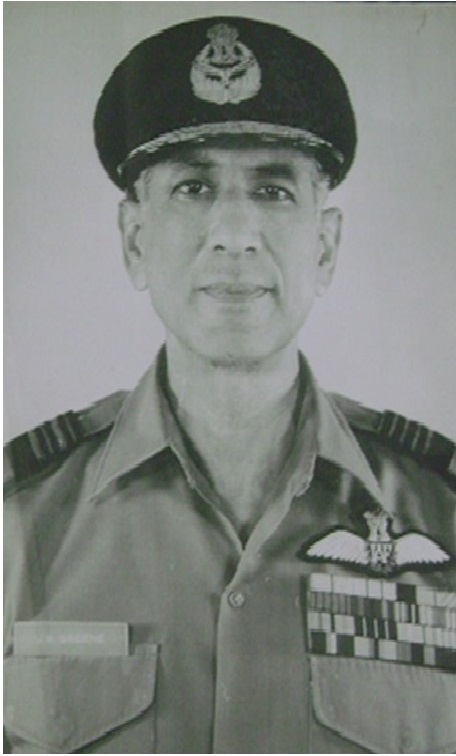 In the initial stages of the operations against Pakistan in the Chhamb Sector, a detachment of Gnat was sent to give cover to our ground attack aircraft and establish our superiority. Squadron Leader Johnny William Greene led missions repeatedly into this sector where the enemy was using missile equipped F-86 Sabre and F-104 Star fighters. He worked out tactics to combat them and, by his personal example and determination, infused confidence in the members of his formation. On 3rd and 4th September 1965, the formations led by him were in the first air combats with the enemy air force. Unmindful of the enemy’s numerical superiority and radar advantage, he controlled and maneuvered his formations with such skill that they succeeded in shooting down two enemy aircraft - the first in these operations. Subsequently, he led a number of formations giving air cover to Mystere and Canberra aircraft in attacks on ground targets. The success of these attacks was largely due to his bravery and leadership. | ||||
| Reference: | Gazette of India , 12th February 1966 - No.15 - Pres/66 dated 1st January 1966 | ||||
| Sqn Ldr | Anthony Louis Mousinho 4418 GD(P) | Unit : No.31 Squadron | Award Date 01 Sep 65 | Announced 01 Jan 66 | |
| Details : | 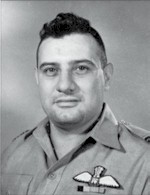 During the recent operations Pakistan, Squadron Leader Anthony Louis Mousinho was the Flight Commander of an Operational Fighter Reconnaissance Squadron. In addition to other operational missions, he led his section of 11 missions against enemy ground positions and pressed home the attacks with courage and determination against a heavy barrage of enemy fire. He undertook dangerous reconnaissance missions in complete disregard of his personal safety. During one such mission he successfully located a tank train, which was subsequently attacked by our aircraft, resulting in 25 Patton tanks being knocked out. His exemplary courage and determination have inspired the men under his command to a high sense of devotion to duty. | ||||
| Reference: | Gazette of India , 12th February 1966 - No.15 - Pres/66 dated 1st January 1966 | ||||
| Sqn Ldr | Sudesh Kumar Dahar 4425 GD(P) | Unit : No.45 Squadron | Award Date 01 Sep 65 | Announced 01 Jan 66 | |
| Details : | 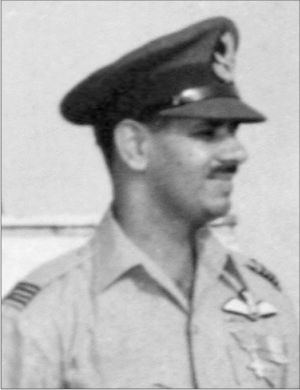 Squadron Leader Sudesh Kumar Dahar was the leader of a Vampire force, which went in action on 1st September 1965 in the Chhamb sector, where a Pakistani force had crossed the border and attacked our positions with heavy armour. Squadron Leader Dahar led the first section, which destroyed six enemy Patton tanks, one anti-aircraft gun position, several trucks and many enemy troops in that area. His section of four Vampire aircraft was attacked by anti-aircraft guns and also by Sabre jets. Skillfully handing the situation, he brought three aircraft safely back to base after a successful mission. His complete disregard of his personal safety was a source of inspiration to the other pilots and his squadron continued to inflict crushing blows on the enemy, destroying enemy supply lines petrol dumps railway wagons, conveys and encampments. The courage and determination displayed by Squadron Leader Sudesh Kumar Dahar were in the highest traditions of the Air Force. | ||||
| Reference: | Gazette of India , 12th February 1966 - No.15 - Pres/66 dated 1st January 1966 | ||||
| Sqn Ldr | Jasbeer Singh 4476 GD(P) | Unit : No.3 Squadron | Award Date 07 Sep 65 | Announced 01 Jan 66 | |
| Details : | 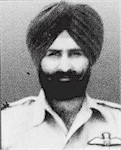 Squadron Leader Jasbeer Singh was serving as a Flight Commander in a fighter squadron operating in the western sector during the operations against Pakistan. On 7th September, 1965, Squadron Leader Jasbeer Singh was detailed as the leader of a strike mission against a high-powered Pakistani radar unit near the Gujranwala airfield, which was greatly hampering our air operations. As his formation was about to attack, Squadron Leader Jasbeer Singh observed four enemy Sabre jets approaching. He immediately warned the formation and undaunted by the interception by the enemy aircraft of superior performance and the intense ground fire, he pressed home his attack and inflicted severe damage on the radar Station. In his final attack, when he had to approach the target very low, his aircraft was hit by ground fire and was seen crashing near the target. In this action, Squadron Leader Jasbeer Singh displayed great valour and unflinching devotion to duty, which were in the finest traditions of the Air Force. | ||||
| Reference: | Gazette of India , 12th February 1966 - No.15 - Pres/66 dated 1st January 1966 | ||||
| Sqn Ldr | Bhupendra Kumar Bishnoi 4594 GD(P) | Unit : No.20 Squadron | Award Date 07 Sep 65 | Announced 01 Jan 66 | |
| Details : | 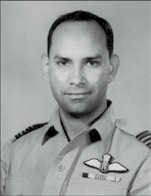 Squadron Leader Bhupendra Kumar Bishnoi arrived at Halwara on 7th September, 1965, for taking part in air operations against Pakistan. Within a period of 15 days, he carried out 16 operational missions of which seven were in close support of the army in the Kasur/Lahore sector. When the enemy ran short o ammunition in the Kasur region Squadron Leader Bishnoi with a formation of four aircraft destroyed a train carrying ammunition at Raiwind Railway Station. The denial of this vital supply was a major factor in causing the enemy to withdraw its armour from this sector with heavy losses. In this other offensive sorties he destroyed or damaged at least ten enemy tanks, armoured vehicles and gun emplacements. Although his aircraft was hit on three different occasions by the enemy ground fire, he pressed home his attacks every time. Throughout these operations, Squadron Leader Bhupendra Kumar Bishnoi displayed courage and leadership in the highest traditions of the Air Force. | ||||
| Reference: | Gazette of India , 12th February 1966 - No.15 - Pres/66 dated 1st January 1966 | ||||
| Sqn Ldr | Chittaranjan Mehta 4615 GD(N) | Unit : No.5 Squadron | Award Date 14 Sep 65 | Announced 01 Jan 66 | |
| Details : | 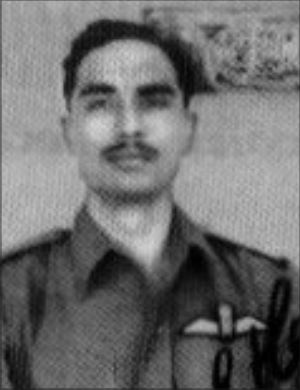 On 14th September 1965, Squadron Leader Chitranjan Mehta was detailed to attack and destroy enemy aircraft and installations at Bhagtanwala. He took off on the night of 14th September, 1965, but half way to the target, all his navigation aids failed. The visibility dropped down to less than one mile and the enemy blackout was so effective that it became impossible to navigate visually. Squadron Leader Mehta immediately took a new route along the river Jhelum. He had to fly very close to a bridge, which was guarded by the enemy with anti-aircraft guns. He skillfully avoided anti-aircraft fire and reached the target. As soon as he reached the airfield, the anti-aircraft guns from Sargodha airfield opened up a heavy barrage on him. To reconnoiter the airfield and to attack the targets, he had to stay over the target for at least 10 minutes. Needless of the anti-aircraft fire and ignoring the risk of being intercepted by missile carrying fighter aircraft that were patrolling a few miles away, Squadron Leader Chitranjan Mehta carried out the reconnaissance successfully. Squadron Leader Chitranjan Mehta carried out nine successful missions and in those he penetrated deep into enemy territory fearlessly by day and by night and inflicted heavy casualties on the enemy. In this mission, Squadron Leader Chitranjan Mehta displayed cool courage, determination and skill of a high order. | ||||
| Reference: | Gazette of India , 12th February 1966 - No.15 - Pres/66 dated 1st January 1966 | ||||
| Sqn Ldr | Sube Singh Malik 4663 GD(P) | Unit : No.7 Squadron | Award Date 06 Sep 65 | Announced 01 Jan 66 | |
| Details : | 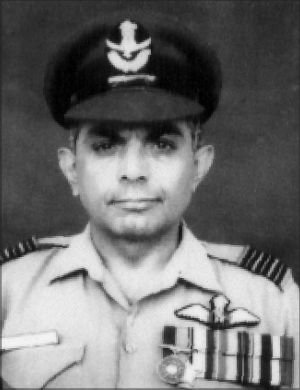 Squadron Leader Sube Singh Malik was engaged in operations against Pakistan as a Flight Commander of a Hunter Squadron. He flew a total of 15 operational missions of which 11 were in close support of the army in the front line. He led formations of Hunter aircraft on offensive air strikes on eight occasions and caused extensive damage and destruction to enemy tanks, vehicles and troops. He pressed home his attacks with determination and courage in spite of heavy enemy ground fire and, on some occasions, enemy interceptor aircraft. On one occasion the control surfaces of his aircraft were damaged but with skill he brought back his aircraft and landed safely at his base. On another occasion he pressed home his attack against a heavily defended target in spite of a warning received from his companion about enemy F-104 aircraft closing in. Undaunted, he completed his task in spite of the heavy odds and brought his formation safely back to base. During another sortie near Harbanspura Railway station, his formation caused extensive damage to enemy armour and gun positions in spite of heavy enemy antiaircraft fire. The courage and tenacity of Squadron Leader Sube Singh Malik were in the highest traditions of the Air Force. | ||||
| Reference: | Gazette of India , 12th February 1966 - No.15 - Pres/66 dated 1st January 1966 | ||||
| Sqn Ldr | Tej Prakash Singh Gill 4755 GD(P) | Unit : No.32 Squadron | Award Date 19 Sep 65 | Announced 01 Jan 66 | |
| Details : | 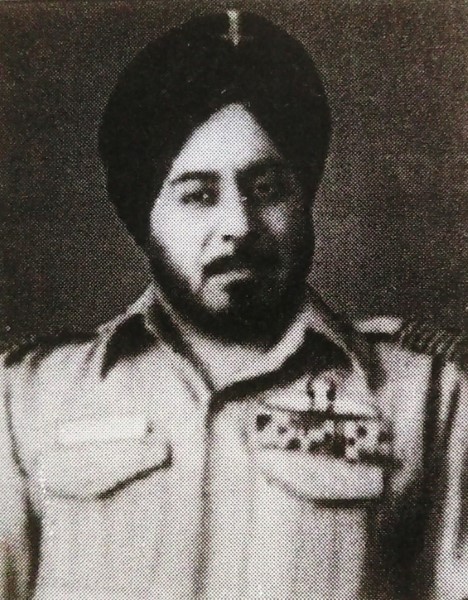 During the operations against Pakistan, Squadron Leader Tej Prakash Singh Gill, the Flight Commander of an Operational Squadron, took part in as many as 21 ground attack missions in support of our ground forces in Sialkot, Chhamb, Lahore and Kasur Sectors. On two such missions on 19th and 21st September, 1965, Squadron Leader T.P.S. Gill encountered a very heavy barrage of anti-aircraft fire. Instead of breaking off the attack squadron Leader Gill pressed it home defiantly in utter disregard of his personal safety and destroyed a considerable amount of enemy armour and field guns. During these missions, Squadron Leader Tej Prakash Singh Gill displayed courage and leadership of a high order. | ||||
| Reference: | Gazette of India , 12th February 1966 - No.15 - Pres/66 dated 1st January 1966 | ||||
| Sqn Ldr | Inder Jeet Singh Parmar 4835 GD(P) | Unit : AFS Jodhpur | Award Date 14 Sep 65 | Announced 01 Jan 66 | |
| Details : | 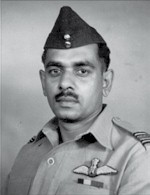 During the operations against Pakistan, Squadron Leader Inder Jeet Singh Parmar carried out sixteen operational sorties out of which seven were low-level reconnaissance missions over enemy concentrations. During these missions, he operated at the extreme limits of the aircraft’s radius of action, very often under enemy anti-aircraft and medium machine gun fire. In one of the sorties, he inflicted heavy damage to an enemy helicopter on the ground. He also carried out nine night air patrols. On the night 14th September 1965 he flew four combat sorties in quick succession after having done a tactical reconnaissance sortie in the afternoon. Single-handed, he succeeded in obstructing enemy bomber and putting them off their bombing aim on our airfield and vital radar installations. In two cases, he chased the enemy bombers away, before they could drop their bombs. In these operations, Squadron Leader Inder Jeet Singh Parmar displayed commendable courage and remarkable flying skill. | ||||
| Reference: | Gazette of India , 19th February 1966 - No.24 - Pres/66 dated 26th January 1966 | ||||
| Sqn Ldr | Ajit Singh Lamba 4877 GD(P) | Unit : No.7 Squadron | Award Date 06 Sep 65 | Announced 01 Jan 66 | |
| Details : | 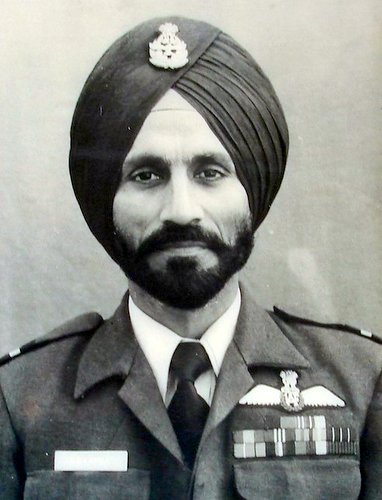 As a Hunter pilot, Squadron Leader Ajit Singh Lamba flew a total of 15 operational sorties, of which 11 were in close support of the army in the Kasur and Lahore sectors. On several of these missions he led formations of Hunter aircraft. He showed great skill and determination in seeking out enemy targets and pressing home his attacks in spite of intensive ground fire and the presence of enemy interceptor aircraft. In spite of heavy opposition, he successfully destroyed several enemy tanks and vehicles. His achievement in the destruction of enemy guns and armour near Harbanspura railway station was specially noteworthy because of the heavy defences surrounding these locations. Throughout the operations Squadron Leader Ajit Singh Lamba showed a marked keenness for action and was always an immediate and ready volunteer for any mission. His courage and devotion to duty inspired other pilots and are in the finest traditions of the Air Force. | ||||
| Reference: | Gazette of India , 12th February 1966 - No.15 - Pres/66 dated 1st January 1966 | ||||
| Sqn Ldr | Pramod Chandra Chopra 5194 GD(P) | Unit : No.8 Squadron | Award Date 11 Sep 65 | Announced 01 Jan 66 | |
| Details : | 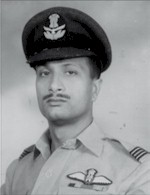 During the recent operations against Pakistan, Flight Lieutenant Pramod Chandra Chopra carried out 14 operational missions and displayed commendable enthusiasm in hunting for the enemy in the sky. On 11th September, 1965, Flight Lieutenant Chopra flew as No. 3 in a four aircraft formation of Mystere on a ground attack strike mission. The formation encountered heavy and concentrated enemy ground fire. Defying the barrage of antiaircraft fire, Flight Lieutenant Pramod Chandra Chopra pressed home his attack and destroyed two enemy tanks in addition to several gun emplacements and vehicles. His courage and determination, which inspired other pilots, were in the best traditions of the Indian Air Force. | ||||
| Reference: | Gazette of India , 12th February 1966 - No.15 - Pres/66 dated 1st January 1966 | ||||
| Flt Lt | Dil Mohan Singh Kahai 5272 GD(P) | Unit : No.1 Squadron | Award Date 07 Sep 65 | Announced 01 Jan 66 | |
| Details : | 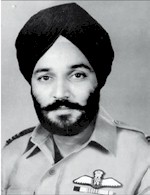 Flight Lieutenant Dil Mohan Singh Kahai was the deputy leader of a Mystere formation, which carried out a daring daylight raid on the very heavily defended Sargodha airfield on 7th September 1965. Despite the intense anti-aircraft fire, he dropped his bombs on four parked aircraft (one F-104 and three F-86) on the Operational Readiness Platform. Then he straffed two more F-86 aircraft and one more F-104 parked on the other Operational Readiness Platform. On 11th September 1965, he flew as No. 2 in a two-aircraft bombing mission over artillery bunkers in the Lahore sector. The bombs dropped by him exploded directly over the bunkers and they were destroyed. On 18th September 1965, flying again as the deputy leader in a four aircraft formation, Flight Lieutenant Kahai scored a direct hit on a gun position near Lahore airfield with rockets and knocked it out. On 19th September, 1965, he led a two aircraft formation and destroyed a Railway Bridge over the Ichhogil canal. The officer also flew a number of strike support missions in which he inflicted damage to enemy equipment and casualties on enemy troops. He also carried out armed patrol sorties near the airfield. The calmness and resolute courage displayed by Flight Lieutenant Dil Mohan Singh Kahai during all these operational missions were a source of inspiration to other pilots and were in the best traditions of the Air Force. | ||||
| Reference: | Gazette of India , 12th February 1966 - No.15 - Pres/66 dated 1st January 1966 | ||||
| Flt Lt | Sharadchandra Naresh Deshpande 5452 GD(N) | Unit : No.5 Squadron | Award Date 06 Sep 65 | Announced 01 Jan 66 | |
| Details : | 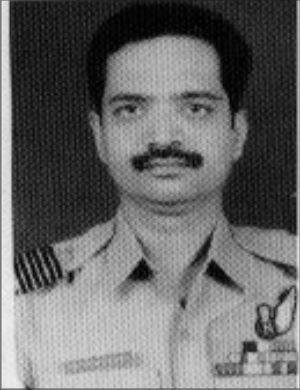 Flight Lieutenant Sharadchandra Naresh Deshpande was serving on the instructional staff of the Jet Bomber Conversion Unit as a navigation instructor when hostilities broke out between India and Pakistan. He volunteered for operational duties and carried out seven operational bombing missions over enemy territory. Flight Lieutenant Deshpande was the navigator/bomb-aimer of the leading aircraft and carried out successful missions in spite of heavy enemy opposition and in total disregard of his own safety. During these bombing operations, he displayed courage, great professional skill and devotion to duty of a high order in the best traditions of the Air Force. | ||||
| Reference: | Gazette of India , 12th February 1966 - No.15 - Pres/66 dated 1st January 1966 | ||||
| Flt Lt | Pradyot Dastidar 5456 GD(N) | Unit : No.5 Squadron | Award Date 15 Sep 65 | Announced 01 Jan 66 | |
| Details : | 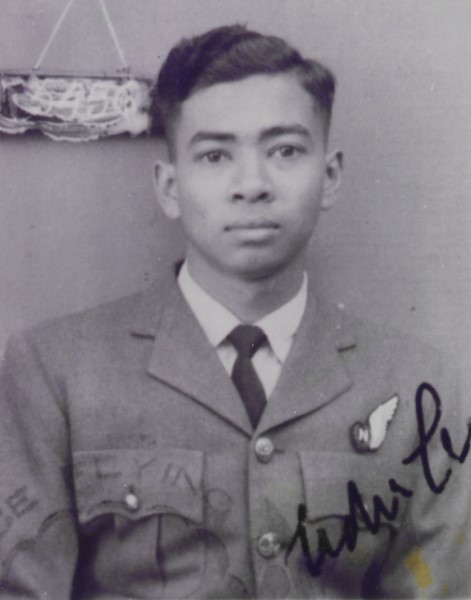 On 15th September 1965, Flight Lieutenant Pradyot Dastidar was detailed as the navigator of a target-marking aircraft to lead a massive attack on Peshawar airfield. This mission was a difficult one and called for the highest skill and accuracy on the part of the navigator. The route passed very near bridges that were defended by the enemy with antiaircraft guns. There was hardly moonlight and the whole area was full of haze. The visibility was so bad that Flight Lieutenant Dastidar saw the airfield only when he was directly overhead. As soon as he dropped a flare to see the target, the anti-aircraft guns opened up a heavy barrage. Undaunted by the shells and tracers he made a steady run and marked the target for the bombing stream coming behind. Then he turned around to see his bomb, while the anti-aircraft guns were firing and shells were bursting around him. After sighting the target-indicating bomb, he passed the bombing index to the leader of the stream. He left the vicinity of the airfield only after he had confirmed that the leader of the stream had received and understood the bombing index. In this mission and in seven other missions, Flight Lieutenant Pradyot Dastidar displayed courage and skill of a high order. | ||||
| Reference: | Gazette of India , 12th February 1966 - No.15 - Pres/66 dated 1st January 1966 | ||||
| Flt Lt | Chandra Sekhar Doraiswami 5601 GD(P) | Unit : No.3 Squadron | Award Date 01 Sep 65 | Announced 01 Jan 66 | |
| Details : | 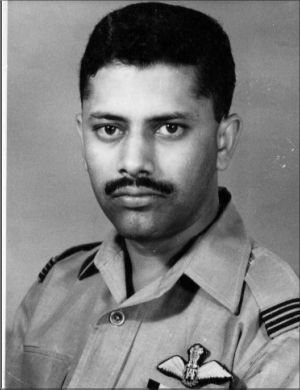 During the operations against Pakistan, Flight Lieutenant Chandra Sekhar Doraiswami took part in 14 operational strike missions against the enemy ground positions. In all his attacks, he displayed great determination inspite of heavy ground fire and enemy air opposition. Twice his aircraft was hit by enemy ground fire and damaged severely. Instead of returning to base, Flight Lieutenant Doraiswami continued on each occasion to press home his attacks in complete disregard of his personal safety and inflicted considerable damage on enemy armour and troops concentrations. Throughout the operations, Flight Lieutenant Chandra Sekhar Doraiswami displayed courage, determination and professional skill of a high order. | ||||
| Reference: | Gazette of India , 12th February 1966 - No.15 - Pres/66 dated 1st January 1966 | ||||
| Flt Lt | Chandra Krishna Kumar Menon 5699 GD(P) | Unit : No.20 Squadron | Award Date 08 Sep 65 | Announced 01 Jan 66 | |
| Details : | 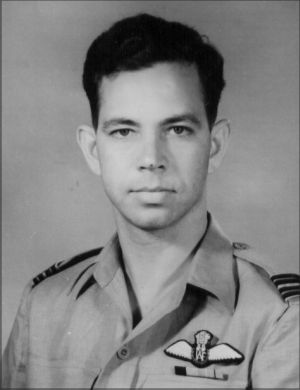 Flight Lieutenant Chandra Krishna Kumar Menon joined a Hunter Squadron at Halwara on 7th September 1965, to take part in operations against Pakistan. By the time the cease-fire came into force he had carried out eight operational sorties of which seven were in close support of the army. On 8th September, 1965, he was detailed to lead a four aircraft formation to engage targets in the Kasur-Lahore sector. His formation destroyed a supply train at Raiwind railway Station. The train was carrying ammunition badly needed by the enemy forces in the Kasur region. The denial of this vital supply of ammunition was a major factor in causing the withdrawal of the enemy armour with heavy losses. During the same mission, a large number of tanks and gun emplacements were also successfully engaged and destroyed or damaged. At least six enemy tanks were destroyed on this occasion. In these sorties, Flight Lieutenant Chandra Krishna Kumar Menon displayed professional skill and utter disregard for his personal safety in the best traditions of the Air Force. | ||||
| Reference: | Gazette of India , 12th February 1966 - No.15 - Pres/66 dated 1st January 1966 | ||||
| Flt Lt | Amarjit Singh Khullar 5854 GD(P) | Unit : No.20 Squadron | Award Date 08 Sep 65 | Announced 01 Jan 66 | |
| Details : | 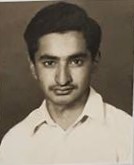 Flight Lieutenant Amarjeet Singh Kullar joined a Hunter Squadron at Halwara on 7th September, 1965, during the operations against Pakistan. Within a fortnight, he carried out eight operational sorties of which seven were in close support of the army. On 8th September, 1965, he flew in a four aircraft formation which destroyed a supply train at Raiwind railway Station. The train was carrying ammunition badly needed by the enemy forces in the Kasur region. The denial of this vital supply was a major factor in causing the withdrawal of enemy armour with very heavy losses. During other operational sorties Flight Lieutenant Kullar destroyed or damaged at least six enemy tanks, armoured vehicles and gun emplacements. He carried out his attacks fearlessly against heavily defended enemy positions and his aircraft was hit by ground fire on three different occasions. Throughout these operations, Flight Lieutenant Amarjeet Singh Kullar displayed courage and leadership in the best traditions of the Air Force. | ||||
| Reference: | Gazette of India , 12th February 1966 - No.15 - Pres/66 dated 1st January 1966 | ||||
| Flt Lt | Vinod Patney 6125 GD(P) | Unit : No.8 Squadron | Award Date 13 Sep 65 | Announced 01 Jan 66 | |
| Details : | 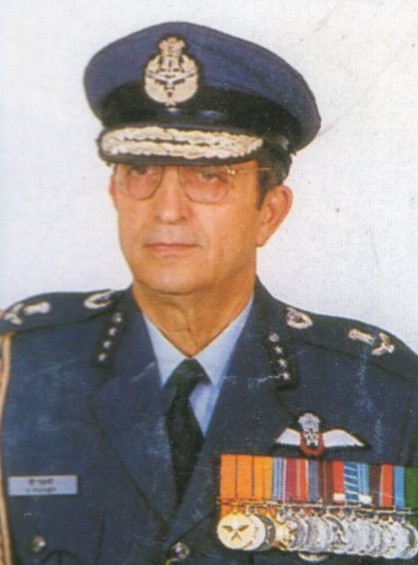 During the operations against Pakistan, Flight Lieutenant Vinod Patney was serving in an Operational Squadron in a forward area. He flew 16 operational sorties within the short period. On 13th September, 1965, he took part in a ground attack mission in the Kasur-Khem Karan Sector and flew as No. 3 in a four aircraft formation. During the attack, the formation met with heavy and determined ground fire from the enemy guns. One of our aircraft was shot down. Undeterred and undaunted by this, Flight Lieutenant Patney pressed home five effective attacks on different enemy targets and destroying 3 Patton tanks. The courage and initiative displayed by Flight Lieutenant Vinod Patney were in the best traditions of the Indian Air Force. | ||||
| Reference: | Gazette of India , 12th February 1966 - No.15 - Pres/66 dated 1st January 1966 | ||||
| Flt Lt | Vinod Kumar Bhatia 6497 GD(P) | Unit : No.8 Squadron | Award Date 08 Sep 65 | Announced 01 Jan 66 | |
| Details : | 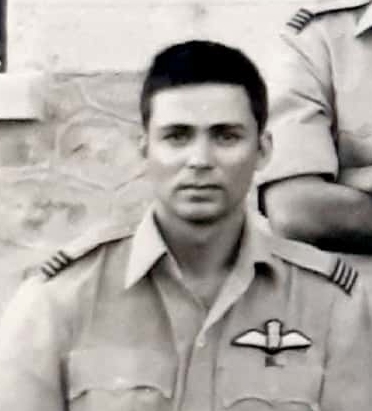 During the operations against Pakistan, Flight Lieutenant Vinod Kumar Bhatia was serving in an Operational Squadron in the Lahore Sector. He flew 18 operational sorties in that Sector. On 8th September, 1965, Flight Lieutenant Bhatia flew as No. 2 in a formation of four Mystere aircraft on a ground attack strike mission. In the face of very heavy and concentrated enemy fire, Flight Lieutenant Bhatia, totally unmindful of the danger, to which he was exposed, pressed home repeated attacks on the enemy tanks and gun positions and destroyed two tanks. The courage and determination displayed by Flight Lieutenant Vinod Kumar Bhatia were in the best traditions of the Indian Air Force. | ||||
| Reference: | Gazette of India , 12th February 1966 - No.15 - Pres/66 dated 1st January 1966 | ||||
| Flt Lt | Gangadhar Ranganath Railkar 5928 GD(N) | Unit : No.106 Squadron | Award Date 22 Sep 65 | Announced 15 Aug 66 | |
| Details : | 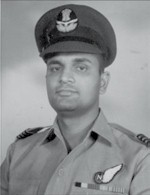 Flight Lieutenant Gangadhar Rangnath Railkar has been a navigator in a Photo Reconnaissance Squadron since 1962. During the September 1965, operations, he undertook several missions and obtained vital information about the enemy dispositions. He always volunteered for the most difficult sorties and flew several operational missions. The valuable information, which he brought by making reconnaissance flights contributed to a large extent towards our planning and successful execution of operations. Throughout, Flight Lieutenant Gangadhar Rangnath Railkar displayed exemplary courage and professional skill of a high order. | ||||
| Reference: | Gazette of India , 8th October 1966 - No.72 - Pres/66 dated 30th September 1966 | ||||
| Flt Lt | Gopal Krishna Garud 6327 GD(N) | Unit : No.106 Squadron | Award Date 22 Sep 65 | Announced 15 Aug 66 | |
| Details : | 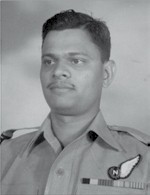 Flight Lieutenant Gopal Krishna Garud has been a navigator in a Photo Reconnaissance Squadron since 1962. Photo reconnaissance flights are fraught with danger as these have invariably to be flown unescorted in broad day light. During the September 1965, operations, he always volunteered for the most difficult missions and brought valuable information which contributed to a large extent towards the planning and successful execution of operations. Throughout, Flight Lieutenant Gopal Krishna Garud displayed exemplary courage and professional skill of a high order. | ||||
| Reference: | Gazette of India , 8th October 1966 - No.72 - Pres/66 dated 30th September 1966 | ||||
